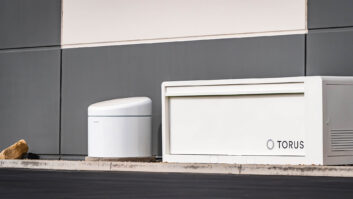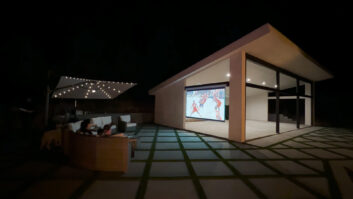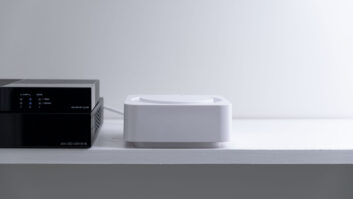Traditionally an ancillary system that was viewed as less integral to other residential technology, lighting control is growing in popularity. Thanks to a confluence of factors, including a growing awareness among homeowners of its aesthetic and economic value and homebuilders increasingly employing it as a mark of distinction from the competition, lighting control is developing into a must have feature for the home.
I am experiencing a much broader acceptance than even two years ago for lighting systems in the home, observed Todd Rosencrans, a sales representative at Connecticut-based Yusen Associates, a sales and marketing firm for the electrical industry. They are much more appreciated now. They have become essential, rather than extravagant.
Lighting controls slow emergence from A/Vs shadow is due in part to growing energy concerns, which has prompted governmental legislation such as Californias Title 24. This legislation requires the use of more energy efficient lighting technologies like compact fluorescent lighting and/or whole-house lighting control systems, explained David Bruce, national sales manager at lighting control brand, Square D Clispal. Any time theres a code change, a product like lighting control goes from a nice to have to a got to have. We anticipate that this trend will spread throughout the country as other states model the California legislation.
Lighting control also has received a big boost from a more unlikely source: homeowners. Influenced by systems seen in the homes of friends, more homeowners are inquiring about the benefits and added value that a lighting control system can offer them.
Lutron has offered whole-house lighting control systems for new construction since 1992 and our wireless products for existing homes since 1997, but now homeowners are realizing that there is an alternative to the 105-year-old light switch, said Jeff Zemanek, director of residential systems at Lutron. They are asking for Lutron lighting control systems not only for the convenience, but also for the aesthetic properties.
With a growth rate approximated at about 30 to 40 percent a year, it is little wonder then that an increasing number of companies are tapping into the lighting control arena, while traditional automation control companies like Crestron are placing more emphasis on their lighting control offerings.
Lighting control is one of the fastest growing segments of our business, said Jim Grath, Crestrons lighting control product manager. We recently introduced the iLux integrated lighting and shade control system, infiNET wireless mesh network lighting, Cameo keypads and more. We have added experienced commercial and residential lighting professionals at every level, including [within the] management and technical staff.
This flurry of interest in lighting control, while giving consumers a plethora of choices, has caused a stir in the residential segment. For manufacturers, it is a matter of keeping one eye on innovating while the other keeps the competition within sight. One wonders if, perhaps, we are losing a bit of perspective on what the consumer wants while we are spending so much time looking at each other, wondered Doug Campbell, director of sales and distribution at LiteTouch.
Perhaps more significant, however, is the impact that a wider field of control systems manufacturers will pose to compatibility and integration with other systems. Gary Meshberg of Genlyte Controls points out that integrators may find themselves working with a particular lighting control system that initially seems great, only to find out that it doesnt meet all of their needs, or worse still, doesnt integrate well or not all. The proliferation of lighting control manufacturers demands that custom installers beef up their product knowledge in an effort to remain abreast of what is out there.
There is a danger associated with taking chances on unproven products, Rosencrans conceded. Everyone can think of systems that have come and gone because they havent met expectations. Some of these companies will have some growing pains, and in my experience, these growing pains are generally felt by the people working on the front linesthe installers. You have to be careful in choosing a product.
As with any expanding market, keeping steady growth is always a key concern. In the case of lighting control, pulling more builders, architects, lighting designers, and interior designers into the fold creates more opportunities for manufacturers and integrators to introduce systems to a broader consumer base.
Lighting control is still fairly new to the U.S. market, said Brad Wills, director of business development at Square D Clipsal. Therefore, the main hurdle is getting the word out through training to designers, architects, and builders so that they understand the full extent of what lighting control can do to differentiate and enhance the aesthetic appeal and functionality of the homes they design and build.
One of the barriers to entry in the past, Campbell noted, is that lighting control was a relatively complex technology. As these systems have been simplified, he believes that not only custom installers, but builders as well, will warm up to the prospect of offering them. The industry at large is acknowledging the complexity issue. Companies like LiteTouch are working hard to drop proprietary standards and programming methods in favor of adopting more industry standard tools that can be used by a broader array of installers, he said.
One of the other challenges in selling lighting control is providing a space in which it can be demonstrated. Selling lighting control is difficult, because unless you are actually in an environment that is outfitted with lighting control and you can see for yourself what lighting control really means, its difficult to sell the concept of lighting control, Campbell said. Talking about features, he added, is not enough. We see far too many dealers trying to talk to the consumer more in terms of features rather than selling lighting control in terms of the benefits associated with it.
Some integrators have already begun to broker relationships with developers and offering base packages to builders, McGrath observed. When the clients see the value and benefit to a lighting control systemthat they can add on to the system as they grow into the house they get very excited.
Zemanek also suggested that installers call upon those with lighting expertise to come on board for projects involving lighting control. Lighting control systems are convenient and wonderful, but the usage can only be as good as what it is controlling, he said. You can have the best surround sound processor in the world controlling the sound in your theater, but if you dont have the right speakers and the right speaker [placement], you will not optimize the system, nor create the ultimate experience for the homeowner. The same is true with lighting.
In taking on lighting control, and conveying it to their customers effectively, many systems integrators stand to set themselves apart from their competition. For dealers venturing into, what for them might be uncharted waters, Crestrons McGrath suggests a well-rounded education in high-voltage electricity and HVAC, as well as familiarization with lighting fixtures by taking manufacturer classes.
As an integrator, they are now interfacing with different subcontractors who will have an impact on the success of the project, he said. They may want to identify leading electrical contractors and lighting designers in their area and partner with them. They need to collaborate with these subcontractors and make sure all efforts are coordinated.
When offering lighting control systems as part of a package, integrators can also see additional revenue through the sale of add-ons such as blinds and drapes. Dont forget about including the control of natural light, Zemanek pointed out. Lutrons ability to control both the electric and the natural light with a single push button is very valuable, and the homeowner wants it. Our terminology has changed from lighting control to light control. Selling Quiet Electronic Drive shades and drapes is not only very profitable, but offers the benefits and the insurance which homeowners will truly appreciate.
The profit potential in offering lighting control seems promising, provided that custom installers who consider adding it to their roster educate themselves and form long-lasting relationships with builders and home designers.
There is going to be a deeper penetration into the largest marketexisting homes, Yusen Associates Rosencrans predicted. We are going to see a lot more RF and PLC integration of lighting control into the homes. Because lighting control is more in demand, the market will grow as the new housing market starts to decline. Its an area that good custom installers should have their eyes on now so that they can get into position to capitalize on this trend.
McGrath, whose telescope points toward a similar horizon, noted that wireless lighting control is already taking off in the retrofit segment. Integrators can now go back and offer lighting control to clients who previously were averse to such a proposal due to cost, convenience, or perceived value, he said. With a cost-effective, reliable solution that does not require construction, lighting control is now offered to more than 90 percent of clients. This has expanded the market and sale for dealers exponentially.
Carolyn Heinze is a freelance writer/editor.







